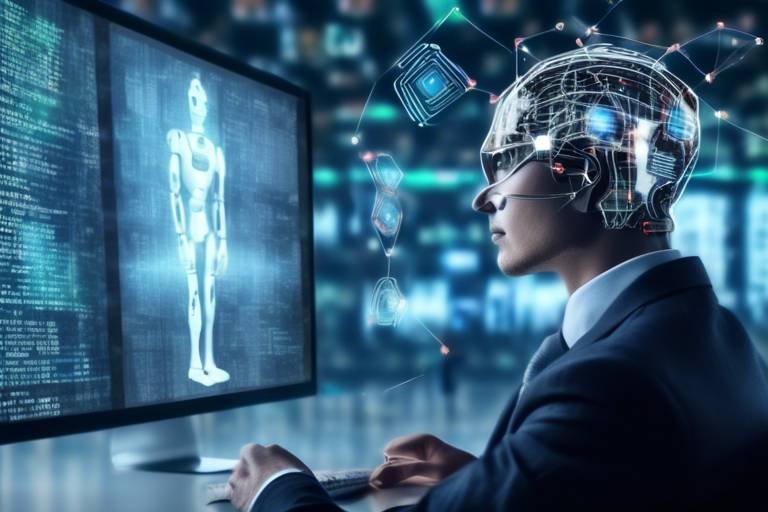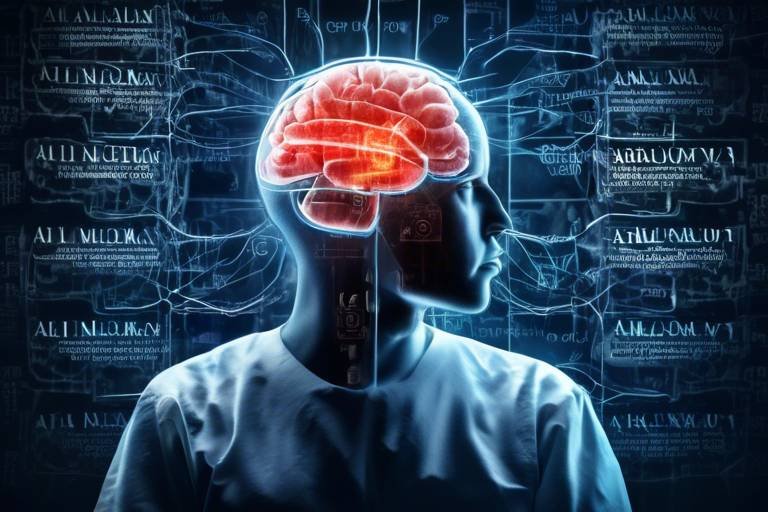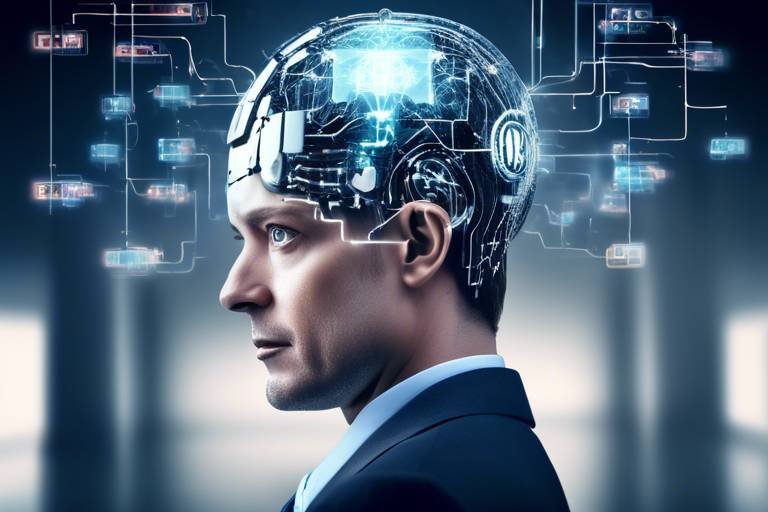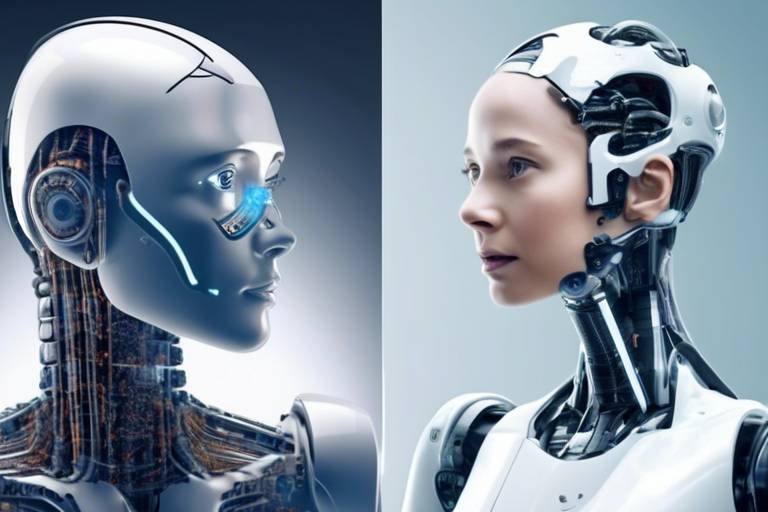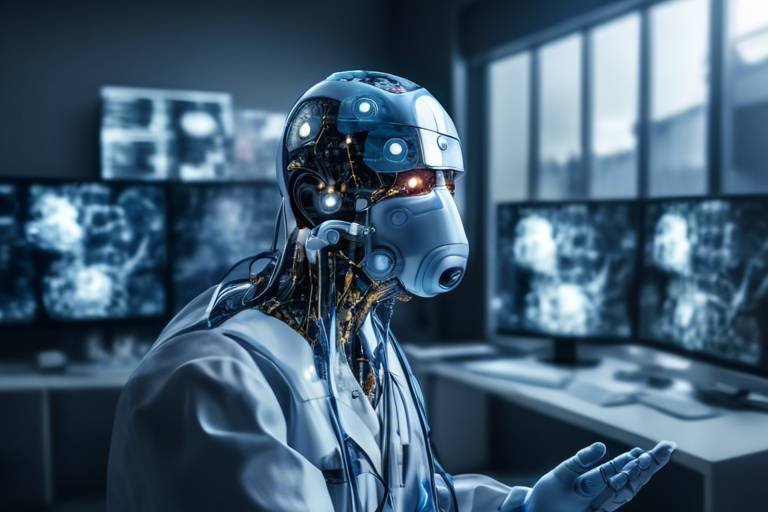AI and Robotics: The Future of Employment
The world is on the brink of a monumental shift, one that intertwines artificial intelligence and robotics with the very fabric of our workforce. As we stand at this crossroads, it’s essential to explore the transformative impact these technologies have on the job market. Picture a landscape where machines and humans collaborate seamlessly, enhancing productivity while also sparking debates about job security and the future of work. Exciting, right? But with every revolution comes its share of challenges and opportunities, and understanding this balance is crucial for workers across all industries.
At the heart of this transformation is the rise of automation. Industries are adopting AI and robotics at a rapid pace, reshaping traditional roles and creating a new paradigm of employment. Imagine walking into a factory where robots handle repetitive tasks, allowing humans to focus on more complex, creative endeavors. This shift doesn’t just mean fewer jobs; it opens the door to new roles that we can only begin to fathom. But what types of jobs are most affected, and which sectors stand to gain the most? The answers lie in the evolving landscape of technology and human capability.
As we delve deeper, it becomes clear that the skills required in the workforce are also changing. The demand for technical skills such as programming, data analysis, and machine learning is surging. Workers must adapt to this new reality, equipping themselves with the tools necessary to thrive in an automated world. But let's not forget about soft skills. In a future where humans and machines collaborate, skills like adaptability, communication, and emotional intelligence will be just as vital. Think of it like a dance: both partners need to be in sync to create something beautiful.
To navigate this evolving landscape, continuous learning is not just a buzzword; it’s a necessity. With technology advancing at breakneck speed, workers must embrace lifelong learning to stay relevant. Whether it’s through online courses, workshops, or professional development programs, the commitment to ongoing education will be the key to unlocking new opportunities in this brave new world.
However, as we explore the balance between job displacement and job creation, it’s crucial to recognize that while some roles may become obsolete, others will emerge. The challenge lies in ensuring that workers are prepared for these new opportunities. This dynamic shift requires a proactive approach from both individuals and organizations to foster an environment where innovation thrives.
Different industries will experience unique challenges and opportunities due to AI and robotics. For instance, the manufacturing sector is witnessing significant advancements through robotics, improving productivity and altering workforce dynamics. In healthcare, AI and robotics are revolutionizing patient care, enhancing efficiency and accuracy. These changes are not just about technology; they’re about how we adapt and grow alongside these innovations.
As we embrace this future, we must also address the ethical considerations that arise with the rise of AI and robotics. Questions about job security, privacy, and the moral implications of automation are at the forefront of this discussion. Ensuring equitable access to technology is crucial, as disparities in how different demographics are affected by automation could exacerbate existing inequalities. Inclusive policies will be essential to navigate this complex landscape and ensure that no one is left behind.
Governments play a pivotal role in shaping the future of work, and potential regulatory frameworks will be necessary to manage the implications of AI and robotics on employment. As we look ahead, collaboration between the public and private sectors will be vital in creating a balanced approach that fosters innovation while protecting workers’ rights.
- Will AI replace all jobs? While AI will automate certain tasks, it will also create new roles that require human oversight and creativity.
- What skills should I develop for the future? Focus on both technical skills like programming and data analysis, as well as soft skills such as adaptability and communication.
- How can I ensure I’m prepared for changes in the job market? Embrace lifelong learning and seek out opportunities for professional development to stay relevant.
- What are the ethical concerns surrounding AI and robotics? Key concerns include job security, privacy, and ensuring equitable access to technology across demographics.

The Rise of Automation
Automation is not just a buzzword; it's a transformative force that is reshaping the landscape of industries across the globe. From manufacturing to retail, the implementation of AI and robotics is driving efficiency and cutting down costs. But what does this really mean for the workforce? As machines take on more tasks, many traditional jobs are being altered or even eliminated. However, it's not all doom and gloom—automation also brings the potential for new job creation.
Let's break it down. The types of jobs most affected by automation typically fall into two categories: repetitive manual tasks and routine cognitive tasks. For instance, positions in assembly lines, data entry, and even some customer service roles are increasingly being replaced by machines that can perform these tasks faster and more accurately. According to a recent study, up to 47% of jobs in the U.S. could be automated within the next two decades. This statistic might sound alarming, but it also signifies a shift towards more skilled positions that machines cannot easily replicate.
On the flip side, automation is also a catalyst for job creation, particularly in sectors that require human oversight, creativity, and emotional intelligence. For example, while robots may handle the assembly of a car, there will still be a need for engineers, designers, and technicians to manage and improve these systems. The key lies in understanding that automation is not merely about replacing human workers; it's about enhancing productivity and creating new roles that didn't exist before.
To illustrate this, consider the following table that highlights the jobs at risk versus emerging opportunities due to automation:
| Job Type | Risk Level | Emerging Opportunities |
|---|---|---|
| Manufacturing Assembly Line Worker | High | Robotics Technician |
| Data Entry Clerk | High | Data Analyst |
| Customer Service Representative | Medium | Customer Experience Manager |
| Warehouse Worker | Medium | Logistics Coordinator |
As we move forward, the challenge lies in how society adapts to these changes. Workers must be proactive in acquiring new skills and embracing lifelong learning. The rise of automation can be seen as an opportunity to innovate and redefine the workforce, rather than a threat to job security. So, how can we prepare for this shift? By focusing on developing skills that complement technology, we can ensure that we remain relevant in an increasingly automated world.
In conclusion, while the rise of automation may lead to job displacement in some areas, it simultaneously opens the door to new opportunities. The future of work will be about collaboration between humans and machines, and those who adapt will thrive in this new landscape. Are you ready to embrace the change?

Skills for the Future
The landscape of employment is changing faster than a speeding bullet, and if you want to stay relevant in this new world, you need to equip yourself with the right skills. As AI and robotics continue to evolve, the demand for specific skills is shifting. So, what exactly should you be focusing on to future-proof your career? Let's dive into the essential skills that will be in high demand and explore how you can prepare for these changes.
First off, let's talk about technical skills. In a world where machines are doing more and more tasks, having a solid grasp of technology is like having a golden ticket. Skills such as programming, data analysis, and machine learning are becoming crucial. Knowing how to write code or analyze data can set you apart from the crowd. Think of it this way: if AI is the new engine, then technical skills are your fuel. Without them, you might find yourself stalled on the side of the road.
But don't just focus on technical abilities; we can't forget about soft skills. In this brave new world, being able to adapt and communicate effectively is just as important as knowing how to code. Imagine trying to collaborate with a robot or an AI system without the ability to communicate clearly. It would be like trying to navigate a maze blindfolded! Skills like problem-solving, creativity, and emotional intelligence will be vital as you work alongside these technologies. They help you understand not only how to use the tools at your disposal but also how to collaborate with others in a tech-driven environment.
Another key aspect to consider is the importance of continuous learning. The rapid pace of technological change means that what you know today might not be enough tomorrow. Embracing a mindset of lifelong learning is crucial. Whether it's taking online courses, attending workshops, or simply reading up on the latest trends, staying informed is your best defense against obsolescence. Think of it as a garden; if you don’t keep watering and nurturing it, the weeds of ignorance will take over.
To give you a clearer picture, here’s a quick overview of the skills that will be essential in the future job market:
| Skill Type | Examples | Importance |
|---|---|---|
| Technical Skills | Programming, Data Analysis, Machine Learning | Critical for working with AI and robotics |
| Soft Skills | Adaptability, Communication, Problem-Solving | Essential for collaboration in a tech-driven environment |
| Continuous Learning | Online Courses, Workshops, Reading | Necessary to keep up with rapid technological changes |
In summary, the future of work is not just about machines taking over; it's also about humans evolving. By honing both your technical and soft skills, while committing to lifelong learning, you can navigate the complexities of an automated world with confidence. So, are you ready to embrace the future?
- What technical skills should I focus on?
Key technical skills include programming languages like Python, data analysis, and familiarity with machine learning algorithms.
- Are soft skills really that important?
Absolutely! Soft skills like communication and adaptability are crucial for working effectively with AI and robotic systems.
- How can I ensure I am continuously learning?
Consider enrolling in online courses, attending industry workshops, and reading up on the latest technological advancements regularly.

Technical Skills
In today's rapidly evolving job market, have become more than just a nice-to-have; they are essential for anyone looking to thrive in an increasingly automated world. As artificial intelligence (AI) and robotics continue to reshape industries, the demand for workers who possess specific technical competencies is skyrocketing. So, what exactly are these skills that can set you apart in this competitive landscape?
First and foremost, programming has emerged as a cornerstone of technical expertise. Whether it’s developing software, creating algorithms, or automating tasks, knowing how to code is invaluable. Languages like Python, Java, and JavaScript are particularly sought after, as they are widely used in various applications, from web development to data analysis. But coding is just the tip of the iceberg; understanding how to leverage data analysis tools is equally critical. As organizations gather more data than ever before, the ability to interpret and analyze this information can provide insights that drive business decisions.
Moreover, familiarity with machine learning and artificial intelligence frameworks is becoming increasingly important. These technologies are not just buzzwords; they are the future of how businesses operate. For instance, knowing how to work with platforms like TensorFlow or PyTorch can open doors to roles that focus on developing intelligent systems that learn and adapt over time.
To further illustrate the importance of these skills, let’s take a look at a table that outlines some of the most in-demand technical skills in today’s job market:
| Technical Skill | Description | Industries |
|---|---|---|
| Programming | Writing code to create software applications and automate tasks. | Tech, Finance, Healthcare |
| Data Analysis | Interpreting complex data sets to inform decision-making. | Marketing, Retail, Research |
| Machine Learning | Developing algorithms that enable computers to learn from data. | Tech, Automotive, Finance |
But it’s not just about technical prowess. Employers are increasingly looking for individuals who can combine these hard skills with problem-solving abilities. The capacity to analyze a situation, identify potential solutions, and implement effective strategies is invaluable in a world where AI is often tasked with routine decision-making. Therefore, honing your analytical skills alongside your technical abilities can significantly enhance your employability.
In conclusion, as AI and robotics continue to evolve, the technical skills you acquire today will determine your relevance in the job market of tomorrow. Embrace learning opportunities, seek out online courses, and network with industry professionals to stay ahead of the curve. Remember, the future belongs to those who are prepared to adapt and grow in an ever-changing landscape.
- What technical skills should I learn first? Start with programming languages like Python or Java, as they form the foundation for many technical roles.
- Are soft skills important in addition to technical skills? Absolutely! Skills like communication and teamwork are essential for collaborating effectively in a tech-driven environment.
- How can I keep my technical skills up to date? Engage in continuous learning through online courses, webinars, and workshops to stay current with industry trends and technologies.

Soft Skills
In the rapidly evolving landscape of AI and robotics, are becoming just as crucial as technical abilities. While machines can process data and perform repetitive tasks with remarkable efficiency, they lack the human touch that is essential in many workplace scenarios. Think about it: when was the last time you felt truly understood by a robot? Exactly! This is where soft skills come into play, bridging the gap between human interaction and machine efficiency.
Soft skills encompass a variety of interpersonal abilities, including communication, teamwork, adaptability, and problem-solving. These skills enable individuals to work effectively with others, navigate complex social situations, and respond to changing environments. For instance, in a team setting, the ability to communicate clearly and empathize with colleagues can lead to enhanced collaboration and innovation. In contrast, a lack of these skills can result in misunderstandings and conflict, which can derail projects and diminish productivity.
Moreover, as AI systems become more integrated into our daily tasks, the need for human oversight and intervention grows. This is where skills like critical thinking and emotional intelligence shine. Workers who can analyze situations, make informed decisions, and understand the emotional dynamics of their teams will be in high demand. Imagine a scenario where a team is facing a tight deadline; a leader with strong emotional intelligence can motivate and rally the team, ensuring that everyone remains focused and engaged, even under pressure.
To illustrate the importance of soft skills in the workplace, consider the following table that compares technical skills with soft skills:
| Technical Skills | Soft Skills |
|---|---|
| Programming languages | Effective communication |
| Data analysis | Team collaboration |
| Machine operation | Adaptability |
| Software proficiency | Problem-solving |
As we move further into an era dominated by AI and robotics, the emphasis on soft skills cannot be overstated. Companies are beginning to recognize that a well-rounded employee—one who possesses both technical prowess and strong interpersonal skills—will drive innovation and growth. Therefore, investing in the development of soft skills is not just beneficial but essential for anyone looking to thrive in the future job market.
In conclusion, while technical skills may open doors, it’s the soft skills that will help you walk through them. Embrace the human elements of your profession, and you’ll not only enhance your employability but also contribute to a more harmonious and productive workplace.
- What are soft skills? Soft skills are interpersonal skills that enable individuals to interact effectively with others, including communication, teamwork, and adaptability.
- Why are soft skills important in the workplace? They are essential for collaboration, problem-solving, and navigating complex social interactions, especially as AI and robotics become more prevalent.
- How can I improve my soft skills? You can improve your soft skills through practice, feedback, and engaging in activities that challenge your interpersonal abilities, such as team projects or public speaking.

Continuous Learning
In today's fast-paced world, the phrase "continuous learning" has become more than just a buzzword; it’s a necessity. With the rapid advancements in AI and robotics, the skills we acquire today may become obsolete tomorrow. Imagine trying to navigate a bustling city without a map or GPS—this is what it feels like for workers who aren't committed to lifelong learning in the age of automation.
So, how can you stay ahead of the curve? First, it's important to understand that continuous learning isn't just about formal education or attending workshops. It encompasses a variety of methods, including:
- Online Courses: Platforms like Coursera, Udemy, and Khan Academy offer a plethora of courses that cater to various skill sets.
- Networking: Engaging with professionals in your field can provide insights into emerging trends and skills that are gaining traction.
- Mentorship: Finding a mentor can be incredibly beneficial. They can guide you through the complexities of new technologies and help you navigate your career path.
- Self-Study: Reading books, articles, and research papers related to your industry can keep you informed about the latest developments.
Moreover, organizations are recognizing the importance of fostering a culture of continuous learning. Companies are increasingly investing in training programs to ensure their employees are equipped with the necessary skills to thrive in an automated environment. This not only benefits the employees but also enhances the overall productivity of the organization. It's a win-win situation!
To illustrate the importance of continuous learning, consider the following table that highlights various skills and the platforms where you can acquire them:
| Skill | Recommended Platforms |
|---|---|
| Data Analysis | Coursera, edX |
| Programming | Codecademy, Udacity |
| Project Management | LinkedIn Learning, PMI |
| Soft Skills | Skillshare, Toastmasters |
In conclusion, embracing continuous learning is not just about keeping up with technology; it's about preparing for a future where adaptability is key. By committing to lifelong education, you’re not only enhancing your skill set but also positioning yourself as a valuable asset in a rapidly changing job market. So, ask yourself: are you ready to invest in your future?
Q1: What is continuous learning?
A1: Continuous learning is the ongoing, voluntary, and self-motivated pursuit of knowledge for personal or professional development.
Q2: Why is continuous learning important in the age of AI?
A2: With rapid technological advancements, skills can quickly become outdated. Continuous learning helps individuals stay relevant and competitive in their fields.
Q3: How can I start my continuous learning journey?
A3: You can start by identifying areas you want to improve in and exploring online courses, workshops, or reading materials that align with your goals.

Job Displacement vs. Job Creation
The conversation around job displacement versus job creation in the age of AI and robotics is not just a trend; it’s a critical dialogue that shapes the future of our workforce. As automation becomes more prevalent, many fear that robots will take over their jobs, leading to widespread unemployment. But is that the whole story? While it's true that certain roles may become obsolete, the reality is much more nuanced. In fact, history shows us that technological advancements often lead to the creation of new jobs, even as they render some positions redundant.
Consider this: when the internet became mainstream, it disrupted numerous industries, but it also birthed entirely new fields like digital marketing, web development, and e-commerce. Similarly, as AI and robotics continue to evolve, they will not only automate repetitive tasks but also open up avenues for roles that we haven't even imagined yet. This duality of destruction and creation is crucial to understanding the full impact of these technologies on the job market.
To illustrate this point, let’s look at a few sectors that are experiencing both job displacement and creation:
| Industry | Jobs Displaced | New Jobs Created |
|---|---|---|
| Manufacturing | Assembly line workers | Robotics technicians |
| Healthcare | Administrative roles | Telehealth coordinators |
| Retail | Cashiers | Customer experience specialists |
As we can see, while automation may eliminate specific jobs, it simultaneously creates opportunities in emerging fields. This leads us to an essential question: how can workers prepare for this shifting landscape? The answer lies in adaptability and continuous learning. By embracing change and upskilling, workers can position themselves to take advantage of new roles that arise from technological advancements.
Moreover, companies are also recognizing the importance of reskilling their workforce. Businesses that invest in training programs not only help their employees transition into new roles but also benefit from a more skilled and versatile workforce. This creates a win-win situation where both employees and employers thrive in the face of change.
In conclusion, while the fear of job displacement is valid, it is equally important to focus on the potential for job creation. The key to navigating this transition lies in a proactive approach to skill development and a willingness to adapt. As we move forward, let’s not just be spectators of this technological revolution but active participants shaping a future where humans and machines can work together harmoniously.
- Will AI really take my job? While some jobs may be automated, new opportunities will also emerge. Focus on developing skills that complement AI.
- What skills should I learn to stay relevant? Technical skills like programming and data analysis, along with soft skills like adaptability and communication, will be crucial.
- How can companies help their employees? By investing in training and development programs, companies can help workers transition into new roles.
- Is there a timeline for job displacement due to AI? The timeline varies by industry, but proactive adaptation is essential to keep up with changes.

Industry-Specific Impacts
The impact of AI and robotics isn't a one-size-fits-all scenario; it varies significantly across different industries. Each sector faces its own unique challenges and opportunities as these technologies become more integrated into daily operations. For instance, in the manufacturing sector, automation has led to a drastic shift in how products are made. Gone are the days when assembly lines were solely manned by human workers. Now, robots are taking on repetitive tasks, allowing human employees to focus on more complex and creative aspects of production. This shift not only increases efficiency but also enhances product quality.
On the other hand, the healthcare industry is experiencing a revolution thanks to AI and robotics. From surgical robots that assist doctors in performing intricate procedures to AI-driven diagnostic tools that analyze patient data with incredible accuracy, technology is enhancing patient care in unprecedented ways. However, this also raises questions for healthcare professionals about their evolving roles and the need for continuous learning to keep pace with these advancements.
Let's take a closer look at how these industries are adapting:
| Industry | Impact of AI and Robotics | Opportunities |
|---|---|---|
| Manufacturing | Increased efficiency and precision in production processes | New roles in robotics maintenance and programming |
| Healthcare | Enhanced diagnostics and treatment options | Emerging positions in health informatics and telemedicine |
| Services | Automation of routine tasks, improving customer experience | Growth in roles focused on customer relations and technology management |
In the services industry, AI is streamlining operations by automating routine tasks, which in turn improves the overall customer experience. For example, chatbots are now handling customer inquiries, allowing human staff to devote their time to more complex issues. This shift not only enhances service delivery but also opens up new job opportunities that focus on managing these technologies and ensuring customer satisfaction.
As we can see, the integration of AI and robotics is not merely about job displacement; it’s about evolution. Workers in these industries must adapt to new technologies and embrace the changes that come with them. The future of work will likely require a blend of traditional industry knowledge and new technological skills, making it an exciting yet challenging landscape for professionals across the board.
Q: Will AI and robotics take away all jobs?
A: While AI and robotics may displace some jobs, they also create new opportunities in emerging fields. Workers will need to adapt and reskill to stay relevant.
Q: What skills will be most important in the future job market?
A: Both technical skills, such as programming and data analysis, and soft skills, like adaptability and communication, will be essential for success in an AI-driven world.
Q: How can workers prepare for the changes brought by AI and robotics?
A: Continuous learning and upskilling are crucial. Workers should seek out training programs, online courses, and professional development opportunities to keep their skills current.

Manufacturing Innovations
The manufacturing industry is undergoing a seismic shift, fueled by the rapid integration of AI and robotics. These technologies are not just enhancing production lines; they are fundamentally changing the way products are designed, produced, and delivered. Imagine a factory where machines communicate seamlessly with each other, optimizing production schedules in real-time to minimize waste and maximize efficiency. This isn't the future—it's happening right now!
At the heart of these innovations lies the concept of smart manufacturing. This approach leverages the Internet of Things (IoT), allowing machines to gather and analyze data from their surroundings. For instance, a robotic arm equipped with sensors can detect when a part is misaligned and automatically adjust its position, ensuring precision and reducing the need for human intervention. This not only speeds up the manufacturing process but also significantly lowers the risk of errors.
Moreover, the implementation of collaborative robots, or cobots, is revolutionizing the workplace. Unlike traditional robots that operate in isolation, cobots are designed to work alongside humans, enhancing productivity without replacing the human workforce. This collaboration allows for a more flexible production environment where workers can focus on higher-value tasks, leaving repetitive and dangerous jobs to robots. The following table outlines some key benefits of using cobots in manufacturing:
| Benefit | Description |
|---|---|
| Increased Efficiency | Cobots can work continuously without fatigue, increasing overall productivity. |
| Enhanced Safety | By taking on hazardous tasks, cobots help reduce workplace injuries. |
| Cost-Effectiveness | Lower operational costs as cobots are generally less expensive to implement than traditional robots. |
| Flexibility | Cobots can be easily reprogrammed for different tasks, adapting to changing production needs. |
But it's not just about efficiency and safety; these innovations are also paving the way for sustainable practices in manufacturing. Companies are increasingly adopting technologies that minimize energy consumption and waste production. For example, AI can analyze energy usage patterns and suggest optimizations, leading to a significant reduction in carbon footprints. As consumers become more environmentally conscious, manufacturers that embrace these changes will not only comply with regulations but also gain a competitive edge in the market.
In summary, the innovations in manufacturing driven by AI and robotics are not merely trends; they are essential transformations that redefine the industry. As we look ahead, it's clear that embracing these technologies will be crucial for manufacturers aiming to stay relevant and competitive. The question is, are we ready to adapt to this new era of manufacturing?
- What are collaborative robots (cobots)? Cobots are designed to work alongside humans in a shared workspace, enhancing productivity and safety.
- How does AI improve manufacturing? AI enhances manufacturing by optimizing processes, predicting maintenance needs, and improving quality control.
- What is smart manufacturing? Smart manufacturing uses IoT technologies to create interconnected systems that improve efficiency and reduce waste.
- Are robots replacing human jobs in manufacturing? While some jobs may be displaced, robots also create new opportunities for workers to focus on more complex tasks.

Healthcare Transformation
The healthcare industry is undergoing a remarkable transformation thanks to the integration of AI and robotics. These technologies are not just enhancing efficiency; they are fundamentally changing how healthcare is delivered. Imagine a world where robots assist surgeons with precision, AI algorithms predict patient outcomes, and telemedicine allows doctors to consult with patients from thousands of miles away. Sounds futuristic, right? Well, it's happening now!
One of the most significant benefits of AI in healthcare is its ability to analyze vast amounts of data quickly. For instance, AI can sift through medical records, research papers, and clinical trials to provide doctors with insights that would take humans much longer to uncover. This capability is particularly useful in diagnosing diseases at an early stage. According to recent studies, AI algorithms can detect conditions such as cancer with a level of accuracy that rivals human specialists. The combination of human intuition and AI's analytical power creates a formidable force in improving patient care.
Robotics is also making waves in the surgical field. Robotic-assisted surgeries allow for minimally invasive procedures, which lead to quicker recovery times and less pain for patients. Surgeons can operate with enhanced precision, thanks to robotic arms that can make minute adjustments that are beyond human capability. For example, the da Vinci Surgical System has transformed prostatectomies and hysterectomies, making them safer and more effective.
However, the transformation doesn't stop at surgeries. AI-powered chatbots are revolutionizing patient interaction. These digital assistants are available 24/7, providing patients with immediate responses to their queries, scheduling appointments, and even reminding them to take their medications. This not only enhances patient engagement but also alleviates some of the burdens on healthcare staff, allowing them to focus on more critical tasks.
Yet, with these advancements come challenges. As healthcare becomes increasingly reliant on technology, issues such as data privacy and security become paramount. Patients need to trust that their sensitive information is protected. Moreover, there is a growing concern about the potential for job displacement among healthcare workers. While AI and robotics will create new roles, they may also render some positions obsolete. It's crucial for healthcare professionals to adapt to these changes through continuous learning and upskilling.
To summarize, the transformation of healthcare through AI and robotics is a double-edged sword. On one side, we have improved patient outcomes, enhanced efficiency, and groundbreaking innovations. On the other, we face ethical dilemmas and the need for a workforce that can adapt to a rapidly changing landscape. As we move forward, the key will be to find a balance that maximizes the benefits of technology while ensuring that healthcare remains a human-centered field.
- How is AI improving patient care? AI enhances patient care by analyzing data for early diagnosis, personalizing treatment plans, and providing decision support for healthcare professionals.
- Will robots replace doctors? While robots will assist in surgeries and routine tasks, the human element in healthcare—such as empathy and complex decision-making—remains irreplaceable.
- What are the risks associated with AI in healthcare? Risks include data privacy issues, the potential for biased algorithms, and the challenge of keeping human oversight in automated processes.

Ethical Considerations
The rapid rise of AI and robotics in the workplace has sparked a myriad of that society must confront. As these technologies increasingly permeate various sectors, questions surrounding job security, privacy, and the moral implications of automation become more pressing. It's crucial to examine how these advancements impact not just the economy, but also the fabric of our society.
First and foremost, the issue of job security cannot be overlooked. With machines taking over tasks traditionally performed by humans, many workers fear for their livelihoods. While some argue that automation will lead to greater efficiency and lower costs, the reality is that this transition can leave a significant number of people without jobs. According to a recent study, it is estimated that up to 30% of jobs could be automated by the year 2030. This potential displacement raises the question: how can we ensure that displaced workers are supported during this transition?
Moreover, the privacy implications of AI technologies pose another ethical dilemma. As companies deploy sophisticated algorithms to collect and analyze data, the risk of personal information being misused is higher than ever. For instance, AI systems can track employee productivity and behavior, leading to concerns about surveillance and the erosion of trust in the workplace. It is essential to establish clear guidelines on how data should be collected, used, and protected to maintain a balance between efficiency and individual privacy rights.
Additionally, the moral implications of relying on machines for decision-making processes must be scrutinized. When AI systems are programmed to make choices, who is responsible for the outcomes? If an autonomous vehicle is involved in an accident, should the blame fall on the manufacturer, the programmer, or the owner? These questions highlight the need for a robust ethical framework that governs the deployment of AI technologies.
To address these ethical concerns effectively, we must consider several key factors:
- Equity and Access: Ensuring that all demographics have equitable access to technology is paramount. Disparities in access can exacerbate existing inequalities, leaving certain groups further behind.
- Transparency: Companies should be transparent about how AI systems operate and the data they collect. This transparency fosters trust and allows individuals to make informed choices regarding their data.
- Regulation: Governments must develop regulatory frameworks that not only promote innovation but also protect workers' rights and privacy. This involves creating policies that address the challenges posed by automation while encouraging responsible use of AI.
In conclusion, as we embrace the technological revolution brought on by AI and robotics, we must not lose sight of the ethical responsibilities that accompany these advancements. By fostering open discussions and implementing thoughtful policies, we can navigate the complexities of automation while ensuring a fair and just society for all.
1. What are the main ethical concerns regarding AI and robotics?
The primary ethical concerns include job security, privacy issues, and the moral implications of machine decision-making. Ensuring that these technologies are used responsibly is crucial.
2. How can we support workers displaced by automation?
Governments and organizations can provide retraining programs, job placement services, and financial support to help workers transition into new roles.
3. What role does transparency play in the ethical use of AI?
Transparency is essential for building trust. Companies should disclose how AI systems work and what data they collect to empower individuals to make informed decisions.
4. Are there regulations in place to govern AI use?
While some regulations exist, there is a growing need for comprehensive frameworks that address the unique challenges posed by AI and robotics in various industries.

Equity and Access
The rapid advancement of AI and robotics has the potential to revolutionize our world, but it also raises critical questions about . As these technologies become more prevalent, it’s essential to ensure that all demographic groups have equal opportunities to benefit from them. Imagine a world where access to cutting-edge technology is as common as having a smartphone; that’s the vision we should strive for. However, the reality is often starkly different.
Disparities in access to technology can exacerbate existing inequalities. For instance, individuals in rural areas may lack the same access to high-speed internet and advanced training programs as those in urban centers. This digital divide can lead to a significant gap in employment opportunities, leaving some groups at a disadvantage. How can we bridge this gap? It's vital to implement policies that promote inclusive access to technology and education.
To tackle these challenges, several strategies can be employed:
- Investment in Infrastructure: Governments and private sectors must collaborate to enhance digital infrastructure, particularly in underserved regions.
- Community Training Programs: Establishing local training initiatives can empower individuals with the skills needed to thrive in an automated workforce.
- Policy Advocacy: Advocating for policies that prioritize equitable access to technology is crucial in ensuring that no one is left behind.
Furthermore, the role of educational institutions cannot be overstated. Schools and universities should integrate technology and robotics into their curricula to prepare students for the future job market. By fostering a culture of lifelong learning, we can equip individuals with the necessary skills to adapt to technological changes.
Ultimately, achieving equity and access in the age of AI and robotics is not just a moral imperative; it is essential for creating a sustainable and prosperous future. If we fail to address these disparities, we risk creating a society where only a select few benefit from technological advancements while others are left behind, widening the gap between the haves and the have-nots.
- What is the digital divide? The digital divide refers to the gap between individuals who have easy access to digital technology and those who do not, often due to socioeconomic factors.
- How can individuals prepare for the future job market? Individuals can prepare by acquiring both technical and soft skills, engaging in continuous learning, and staying updated on industry trends.
- What role do governments play in ensuring equity in technology access? Governments can implement policies that promote infrastructure development, support community training programs, and advocate for fair access to technology.

Regulatory Frameworks
As we venture deeper into the era of AI and robotics, the importance of cannot be overstated. Governments around the world are grappling with how to effectively manage the implications of these technologies on employment, privacy, and society at large. But what does this really mean for the average worker? Well, it’s a mixed bag of opportunities and challenges. On one hand, regulations can help safeguard jobs and ensure fair practices, while on the other, they may inadvertently stifle innovation if not designed thoughtfully.
One of the primary roles of regulatory frameworks is to create a balance between innovation and protection. For instance, regulations can ensure that companies adopting AI technologies are held accountable for their impact on employment. This can involve guidelines on how to transition workers into new roles or retraining programs that equip them with the necessary skills to thrive in an automated environment. Moreover, regulations can set standards for ethical AI use, ensuring that algorithms are transparent and do not perpetuate biases.
In addition to protecting workers, regulatory frameworks can also foster an environment where innovation can flourish. By establishing clear guidelines, companies can invest in AI and robotics without fear of legal repercussions or public backlash. This is particularly important in sectors like healthcare and manufacturing, where the implications of automation can be profound. For example, regulations might dictate how robots can be utilized in surgical procedures, ensuring that patient safety remains paramount.
However, the challenge lies in the fact that technology evolves at a breakneck speed, often outpacing the ability of regulatory bodies to keep up. As such, a dynamic regulatory approach is essential. This might involve periodic reviews of existing laws and the introduction of adaptive regulations that can respond to new technological advancements. For instance, countries could implement a framework that allows for pilot programs where AI technologies can be tested under regulatory oversight before full-scale deployment.
Another critical aspect of regulatory frameworks is the need for international cooperation. Given that AI and robotics are global phenomena, countries must collaborate to establish common standards and practices. This can help prevent a race to the bottom, where companies relocate to jurisdictions with lax regulations, ultimately undermining worker protections globally. By working together, nations can create a cohesive strategy that promotes ethical AI development while ensuring that no one is left behind.
To summarize, the development of robust regulatory frameworks is crucial in navigating the complexities introduced by AI and robotics. It requires a careful balance between protecting jobs, fostering innovation, and ensuring ethical practices. As we look towards the future, it is imperative that stakeholders—including governments, businesses, and workers—engage in meaningful dialogue to shape a regulatory landscape that benefits all.
- What are regulatory frameworks in the context of AI and robotics?
Regulatory frameworks refer to the set of laws and guidelines established by governments to manage the development and implementation of AI and robotics technologies. - Why are regulatory frameworks important?
They are essential for ensuring ethical practices, protecting jobs, and fostering innovation in the face of rapid technological advancements. - How can governments ensure that regulations keep pace with technology?
By adopting a dynamic regulatory approach that includes periodic reviews and adaptive regulations, governments can stay ahead of technological changes. - What role does international cooperation play in regulatory frameworks?
International cooperation helps establish common standards, preventing companies from exploiting lax regulations in other countries and ensuring equitable treatment for workers globally.
Frequently Asked Questions
- What types of jobs are most affected by automation?
Automation primarily impacts jobs that involve repetitive tasks or predictable processes. Roles in manufacturing, data entry, and even some customer service positions are at higher risk. However, while some jobs may disappear, new ones will emerge that require different skill sets.
- What skills should I develop to stay relevant in the job market?
To thrive in an increasingly automated world, focus on enhancing both technical and soft skills. Technical skills like programming, data analysis, and familiarity with AI tools are crucial. Meanwhile, soft skills such as adaptability, problem-solving, and effective communication will help you work alongside AI and robotic systems.
- How can I prepare for continuous learning?
Embrace a mindset of lifelong learning! You can take online courses, attend workshops, and engage in professional development opportunities. Additionally, staying updated with industry trends and networking with professionals in your field can provide valuable insights and resources.
- Will automation lead to job loss or job creation?
It's a mixed bag! While automation may displace certain jobs, it also has the potential to create new roles that we can't even imagine yet. The key is to focus on reskilling and adapting to the changing job landscape to seize new opportunities.
- How are different industries adapting to AI and robotics?
Industries are responding in unique ways. For instance, manufacturing is leveraging robotics to boost productivity, while healthcare is using AI to enhance patient care and streamline processes. Each sector faces distinct challenges and opportunities, and adaptability is crucial for success.
- What ethical concerns arise from the rise of AI and robotics?
There are several ethical considerations, including job security, privacy issues, and the overall impact of automation on society. It's essential to address these concerns to ensure that technological advancements benefit everyone and do not exacerbate existing inequalities.
- How can we ensure equitable access to technology?
To promote equity, it's vital to implement inclusive policies that consider the needs of diverse demographics. This might involve investing in education and training programs that prepare underrepresented groups for the jobs of the future, ensuring everyone has a fair chance to succeed in an automated world.
- What role do governments play in regulating AI and robotics?
Governments are crucial in establishing regulatory frameworks that manage the implications of AI and robotics on employment. They can create policies that protect workers, promote fair practices, and encourage innovation while ensuring that technological advancements benefit society as a whole.


